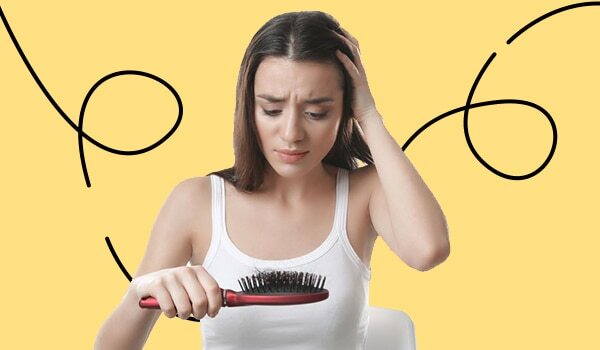Minoxidil is a medicated compound that is used to treat hair loss and hair thinning in women. This topical solution for preventing baldness is a highly effective treatment for female hair loss. Minoxidil for women also boasts of an excellent track record for being a safe solution, especially for women who do not have too many options for medication for hair loss. Sold as a foam and a spray, minoxidil helps prevent your hair from falling out and is one of the popular medications prescribed by hair experts. To understand how minoxidil affects the hair growth, it's proper application techniques and precautions to be followed, we contacted Dr. Pallavi Sule, Dermatologist and Aesthetic Physician for tips. According to her, "Minoxidil is a vasodilator, meaning it dilates blood vessels and increases the flow of oxygen, nutrients and blood to hair follicles. Thus helping in hair regrowth and increasing the density of hair." As for everything else you need to know about this hair loss treatment for women, read on.
01The causes of hair loss on women
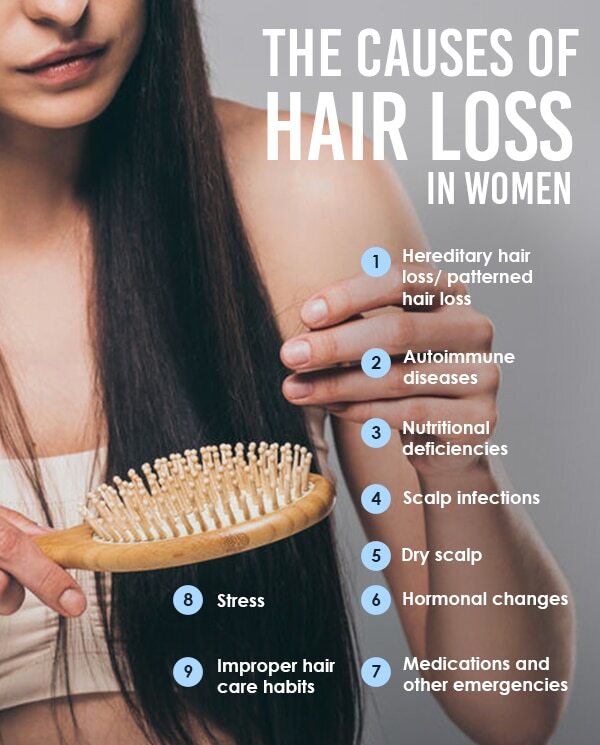
1. Hereditary hair loss/ patterned hair loss:
Caused by androgens and genetics, androgenic hair loss is gradual in nature. It starts with the hairline, reducing the hair thickness over several years or even decades.
2. Autoimmune diseases:
Termed as "alopecia areata', this autoimmune disease makes your immune system mistakenly attack your own hair follicles, resulting in thinning and hair loss.
3. Nutritional deficiencies:
A diet that lacks protein, iron and other essential vitamins and minerals, can affect your hair health. Nutritional deficiencies account for 9-20% of cases of iron-deficient anemia, which often leads to visible hair thinning in women.
4. Scalp infections:
If left untreated, bacterial (folliculitis, impetigo) and fungal (ringworm) infections on the scalp can lead to hair loss.
5. Dry scalp:
Excessive dryness in the scalp can lead to conditions like psoriasis and seborrheic dermatitis, and cause hair loss.
6. Medications and other emergencies:
Medical Factors like sudden blood loss, chemotherapy, and medications to treat an illness like cancer can result in hair thinning.
7. Hormonal changes:
A change in hormonal levels in the body caused by pregnancy, childbirth, or menopause can affect the thickness of your mane.
8. Stress:
A result of busy lifestyles, stress and depression can also induce hair loss in women.
9. Improper hair care habits:
Improper hair care practices like wearing damaging hairstyles or issues of grooming and sub-standard styling products, all can lead to hair loss as well.
02The relationship between minoxidil and hair growth
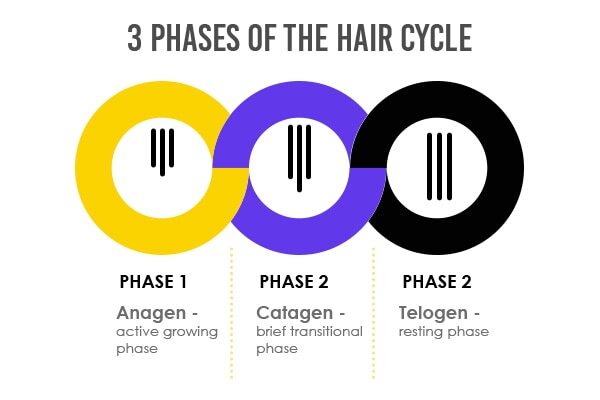
To understand the role of minoxidil in hair loss, learning about the independent hair cycle that the follicle goes through is important. There are three phases in the hair cycle.
- Anagen - active growing phase About 90-95% of hair belongs in the anagen phase at any given time and it can last up to 3 years.
- Catagen - brief transitional phase The catagen phase is a transitional phase where the hair has reached full growth potential and prepares for the next phase; it can last for 3 weeks.
- Telogen - resting phase The telogen phase is the last step in the hair growth cycle and can last from a few weeks to months. According to Dr. Sule, "The normal hair shedding is 50-100 hair per day. If the hair count of lost hair is more than this, which can easily be gauged by keeping a close watch on the hair shed during combing, washing and that shed on the pillow, etc. You need to see a doctor. Usually, the lost hair is replaced by new hair. When there is no growth observed, this is called hair loss. Hence it is said that** minoxidil prolongs the anagen (growth phase) in the dermal papilla, increasing the anagen follicular size and follicle percentage."**
03How to use minoxidil to treat hair loss?
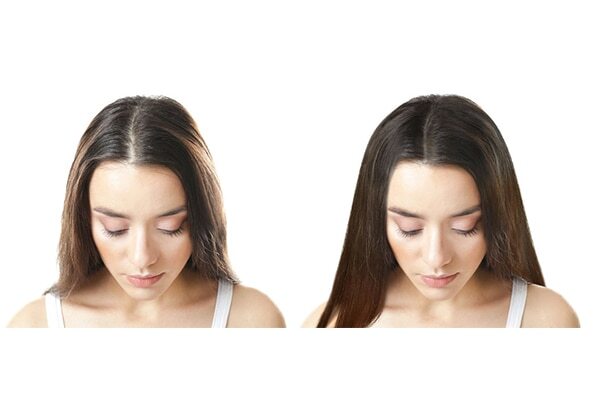
The potent medication, minoxidil is used to control hair loss and thinning in women. The recommended dosage is 2% minoxidil solution or foam to be applied twice a day in a measured 1ml quantity. Once you start with minoxidil, you may experience hair loss in the initial 4 weeks. The reason is, minoxidil accelerates the hair growth and hence results in the shedding of the dead hair. This makes space for a new anagen or growing hair to fill in the follicular unit.
04How long does minoxidil take to work?
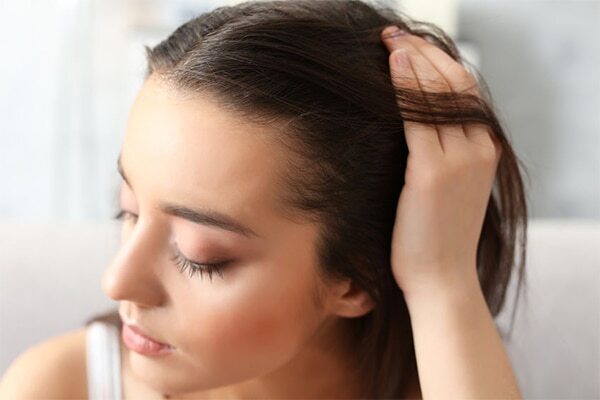
According to Dr. Sule, "One can observe new growth at the fifth or sixth week of treatment with minoxidil. Regular and consistent use of minoxidil in the dosage of 1ml twice a day on the bald patches, improves the visible hair growth in 4 to 6 months of time. In some cases, it might take longer, which is why it is recommended to take professional advice from a board-certified dermatologist," she elaborated.
05Precautions to take while using minoxidil for women

Dr. Sule's expert tips on using minoxidil for hair loss treatment: i) Always apply the solution on the scalp in a measured quantity ii) Use the tip of your fingers and massage the scalp gently, do not rub aggressively iii) Remember to wash your hands and not to touch your face or any other place as it can cause hair growth at the place As a precautionary, our expert also revealed a personal experience saying, "One of my patients was using minoxidil for hair loss. Suddenly she started complaining of hair growth on her face. When I grilled her, I found out that she used to apply the minoxidil first on her scalp, and without washing her hands she would do her skincare regimen soon after. This resulted in hair growth on the face!!! Pregnancy and lactating mothers are also a contraindication." So make sure to consult a professional before starting the treatment!
06FAQs about minoxidil for women
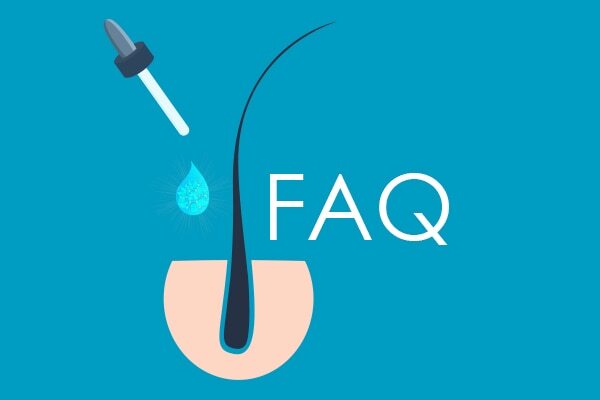
1. What are the side effects of using minoxidil for hair loss?
**A. **There is a possibility of over-application of minoxidil, which can lead to absorption by the body. The side effects of that include dizziness, drowsiness, tiredness, and. temporary edema. However, the swelling that occurs while using the medication only lasts the first few weeks, after which the body adjusts to it.
2. Can you apply minoxidil all over your hair?
**A. **Applying minoxidil all over your scalp and hair can be a waste of product. It is recommended to only be applied to affected areas as a once-daily topical treatment. Since it is safe to use with most hair products, you can keep your existing hair care routine to take care of the rest of your scalp and hair.
3. What happens if you miss a day of applying minoxidil?
**A. **A missed dose of minoxidil is not a serious issue. Apply the missed dose as soon as you can and if it's time for your next dose, just skip the missed one altogether.
4. Is 5% minoxidil safe for women?
**A. **While women are recommended to use 2% minoxidil foam, the 5% concentration has only been recently deemed safe as well. However, consult your dermatologist before settling on a final decision.
5. Do you need to shampoo before applying minoxidil?
**A. **Since minoxidil is a potent medication your scalp doesn't have to be squeaky clean before application. You can also apply the medication on one to two-day-old hair as well.

